BPR's Impact on Employee Productivity: Saudi Arabia Utility Sector
VerifiedAdded on 2023/05/29
|59
|15900
|145
Report
AI Summary
This report presents a comprehensive analysis of the impact of Business Process Reengineering (BPR) on employee productivity within the project management department of a Saudi Arabian utility sector. The study begins with an extensive literature review, exploring the evolution, conception, and evaluation of BPR, alongside its implementation in public sector organizations and related challenges. The methodology section details the research paradigm, ontological and epistemological positioning, and methodological choices, including the use of qualitative and quantitative methods. The results and discussion chapter presents demographic data, analyzes reengineering initiatives in the Saudi Arabian oil and gas sector, and assesses the impact of BPR on employee productivity, considering factors such as staff development, strategy, technology, and organizational changes. The report also addresses challenges encountered during reengineering efforts, offering a holistic understanding of BPR's influence on organizational performance and employee outcomes. The report is a valuable resource for students seeking to understand the practical implications of BPR.
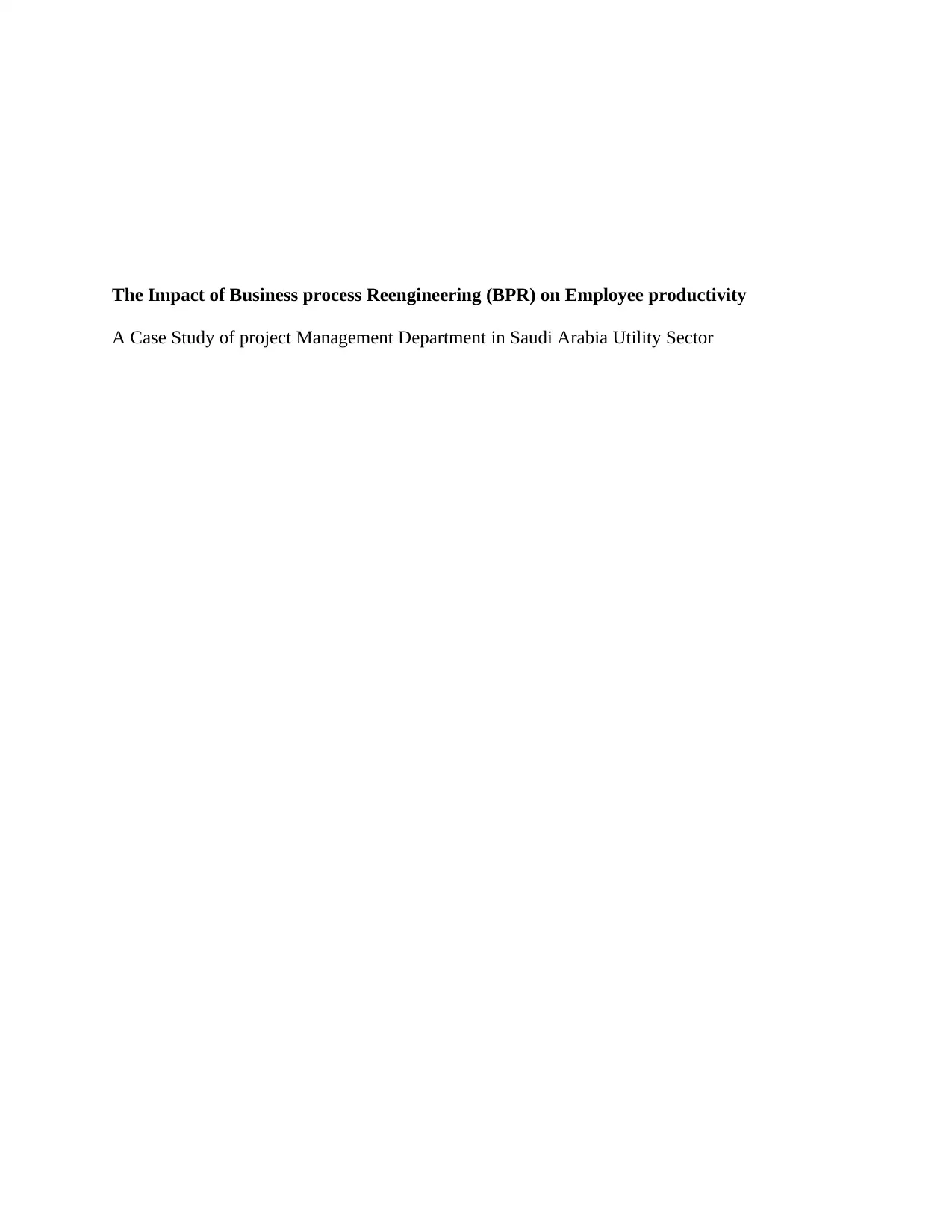
The Impact of Business process Reengineering (BPR) on Employee productivity
A Case Study of project Management Department in Saudi Arabia Utility Sector
A Case Study of project Management Department in Saudi Arabia Utility Sector
Paraphrase This Document
Need a fresh take? Get an instant paraphrase of this document with our AI Paraphraser
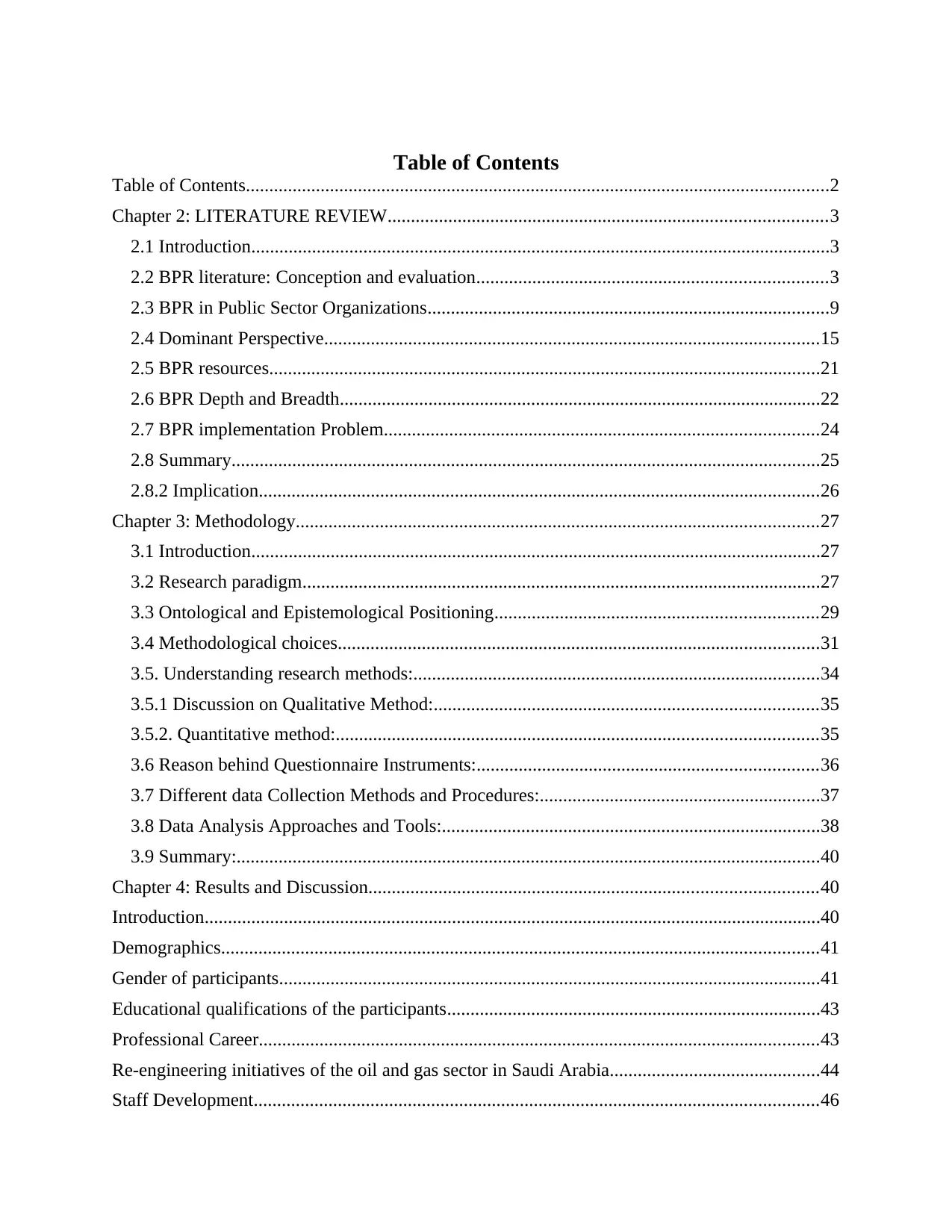
Table of Contents
Table of Contents.............................................................................................................................2
Chapter 2: LITERATURE REVIEW..............................................................................................3
2.1 Introduction............................................................................................................................3
2.2 BPR literature: Conception and evaluation...........................................................................3
2.3 BPR in Public Sector Organizations......................................................................................9
2.4 Dominant Perspective..........................................................................................................15
2.5 BPR resources......................................................................................................................21
2.6 BPR Depth and Breadth.......................................................................................................22
2.7 BPR implementation Problem.............................................................................................24
2.8 Summary..............................................................................................................................25
2.8.2 Implication........................................................................................................................26
Chapter 3: Methodology................................................................................................................27
3.1 Introduction..........................................................................................................................27
3.2 Research paradigm...............................................................................................................27
3.3 Ontological and Epistemological Positioning.....................................................................29
3.4 Methodological choices.......................................................................................................31
3.5. Understanding research methods:.......................................................................................34
3.5.1 Discussion on Qualitative Method:..................................................................................35
3.5.2. Quantitative method:.......................................................................................................35
3.6 Reason behind Questionnaire Instruments:.........................................................................36
3.7 Different data Collection Methods and Procedures:............................................................37
3.8 Data Analysis Approaches and Tools:.................................................................................38
3.9 Summary:.............................................................................................................................40
Chapter 4: Results and Discussion................................................................................................40
Introduction....................................................................................................................................40
Demographics................................................................................................................................41
Gender of participants....................................................................................................................41
Educational qualifications of the participants................................................................................43
Professional Career........................................................................................................................43
Re-engineering initiatives of the oil and gas sector in Saudi Arabia.............................................44
Staff Development.........................................................................................................................46
Table of Contents.............................................................................................................................2
Chapter 2: LITERATURE REVIEW..............................................................................................3
2.1 Introduction............................................................................................................................3
2.2 BPR literature: Conception and evaluation...........................................................................3
2.3 BPR in Public Sector Organizations......................................................................................9
2.4 Dominant Perspective..........................................................................................................15
2.5 BPR resources......................................................................................................................21
2.6 BPR Depth and Breadth.......................................................................................................22
2.7 BPR implementation Problem.............................................................................................24
2.8 Summary..............................................................................................................................25
2.8.2 Implication........................................................................................................................26
Chapter 3: Methodology................................................................................................................27
3.1 Introduction..........................................................................................................................27
3.2 Research paradigm...............................................................................................................27
3.3 Ontological and Epistemological Positioning.....................................................................29
3.4 Methodological choices.......................................................................................................31
3.5. Understanding research methods:.......................................................................................34
3.5.1 Discussion on Qualitative Method:..................................................................................35
3.5.2. Quantitative method:.......................................................................................................35
3.6 Reason behind Questionnaire Instruments:.........................................................................36
3.7 Different data Collection Methods and Procedures:............................................................37
3.8 Data Analysis Approaches and Tools:.................................................................................38
3.9 Summary:.............................................................................................................................40
Chapter 4: Results and Discussion................................................................................................40
Introduction....................................................................................................................................40
Demographics................................................................................................................................41
Gender of participants....................................................................................................................41
Educational qualifications of the participants................................................................................43
Professional Career........................................................................................................................43
Re-engineering initiatives of the oil and gas sector in Saudi Arabia.............................................44
Staff Development.........................................................................................................................46
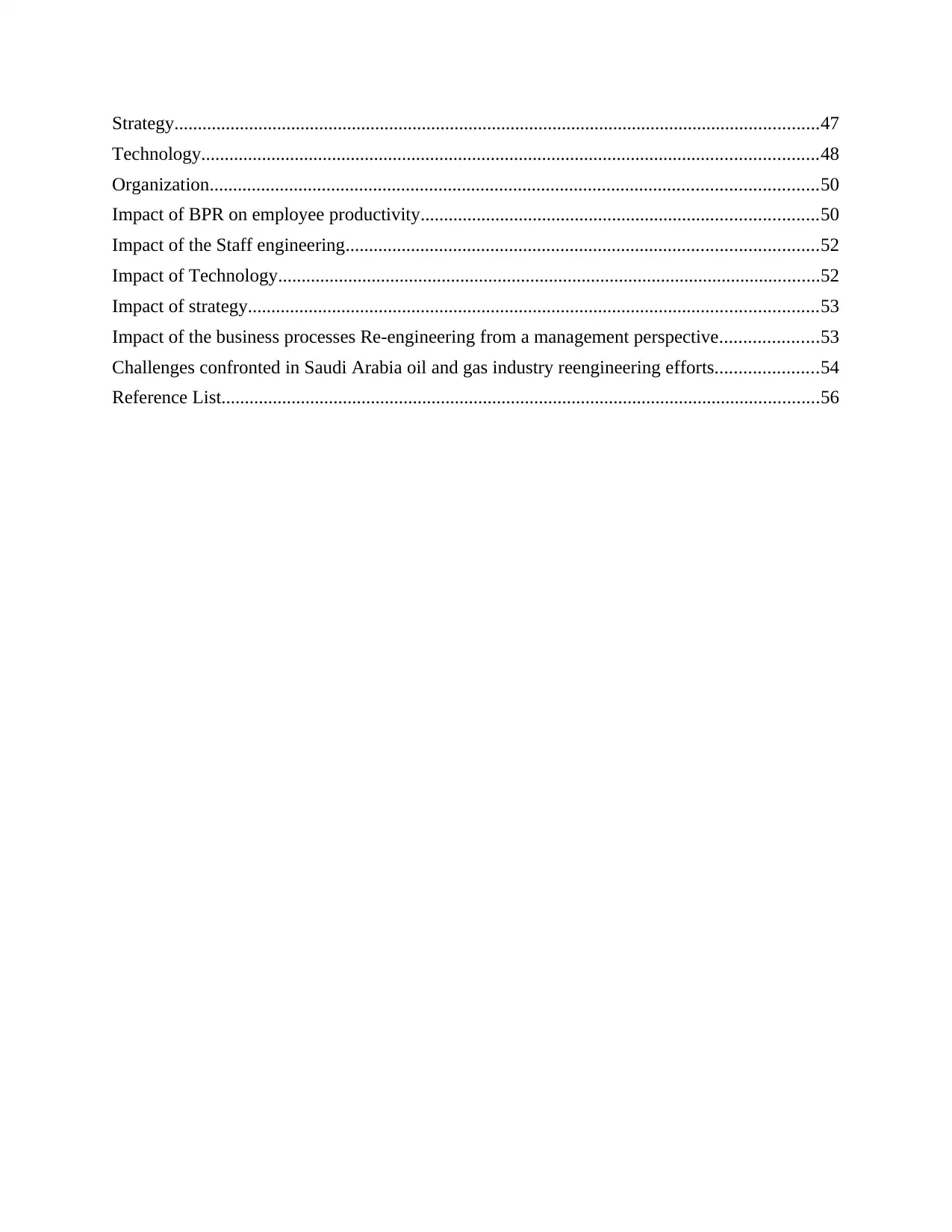
Strategy..........................................................................................................................................47
Technology....................................................................................................................................48
Organization..................................................................................................................................50
Impact of BPR on employee productivity.....................................................................................50
Impact of the Staff engineering.....................................................................................................52
Impact of Technology....................................................................................................................52
Impact of strategy..........................................................................................................................53
Impact of the business processes Re-engineering from a management perspective.....................53
Challenges confronted in Saudi Arabia oil and gas industry reengineering efforts......................54
Reference List................................................................................................................................56
Technology....................................................................................................................................48
Organization..................................................................................................................................50
Impact of BPR on employee productivity.....................................................................................50
Impact of the Staff engineering.....................................................................................................52
Impact of Technology....................................................................................................................52
Impact of strategy..........................................................................................................................53
Impact of the business processes Re-engineering from a management perspective.....................53
Challenges confronted in Saudi Arabia oil and gas industry reengineering efforts......................54
Reference List................................................................................................................................56
⊘ This is a preview!⊘
Do you want full access?
Subscribe today to unlock all pages.

Trusted by 1+ million students worldwide
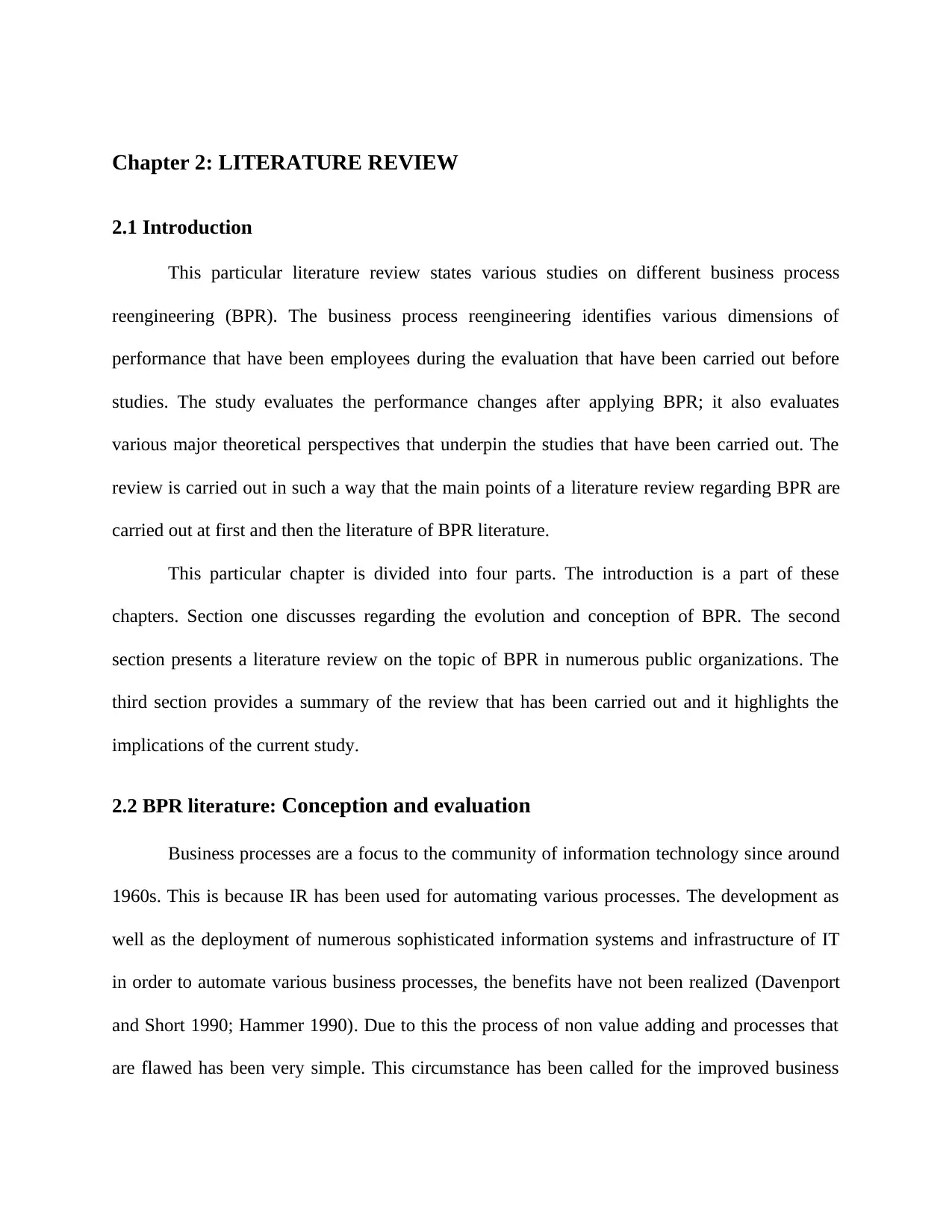
Chapter 2: LITERATURE REVIEW
2.1 Introduction
This particular literature review states various studies on different business process
reengineering (BPR). The business process reengineering identifies various dimensions of
performance that have been employees during the evaluation that have been carried out before
studies. The study evaluates the performance changes after applying BPR; it also evaluates
various major theoretical perspectives that underpin the studies that have been carried out. The
review is carried out in such a way that the main points of a literature review regarding BPR are
carried out at first and then the literature of BPR literature.
This particular chapter is divided into four parts. The introduction is a part of these
chapters. Section one discusses regarding the evolution and conception of BPR. The second
section presents a literature review on the topic of BPR in numerous public organizations. The
third section provides a summary of the review that has been carried out and it highlights the
implications of the current study.
2.2 BPR literature: Conception and evaluation
Business processes are a focus to the community of information technology since around
1960s. This is because IR has been used for automating various processes. The development as
well as the deployment of numerous sophisticated information systems and infrastructure of IT
in order to automate various business processes, the benefits have not been realized (Davenport
and Short 1990; Hammer 1990). Due to this the process of non value adding and processes that
are flawed has been very simple. This circumstance has been called for the improved business
2.1 Introduction
This particular literature review states various studies on different business process
reengineering (BPR). The business process reengineering identifies various dimensions of
performance that have been employees during the evaluation that have been carried out before
studies. The study evaluates the performance changes after applying BPR; it also evaluates
various major theoretical perspectives that underpin the studies that have been carried out. The
review is carried out in such a way that the main points of a literature review regarding BPR are
carried out at first and then the literature of BPR literature.
This particular chapter is divided into four parts. The introduction is a part of these
chapters. Section one discusses regarding the evolution and conception of BPR. The second
section presents a literature review on the topic of BPR in numerous public organizations. The
third section provides a summary of the review that has been carried out and it highlights the
implications of the current study.
2.2 BPR literature: Conception and evaluation
Business processes are a focus to the community of information technology since around
1960s. This is because IR has been used for automating various processes. The development as
well as the deployment of numerous sophisticated information systems and infrastructure of IT
in order to automate various business processes, the benefits have not been realized (Davenport
and Short 1990; Hammer 1990). Due to this the process of non value adding and processes that
are flawed has been very simple. This circumstance has been called for the improved business
Paraphrase This Document
Need a fresh take? Get an instant paraphrase of this document with our AI Paraphraser
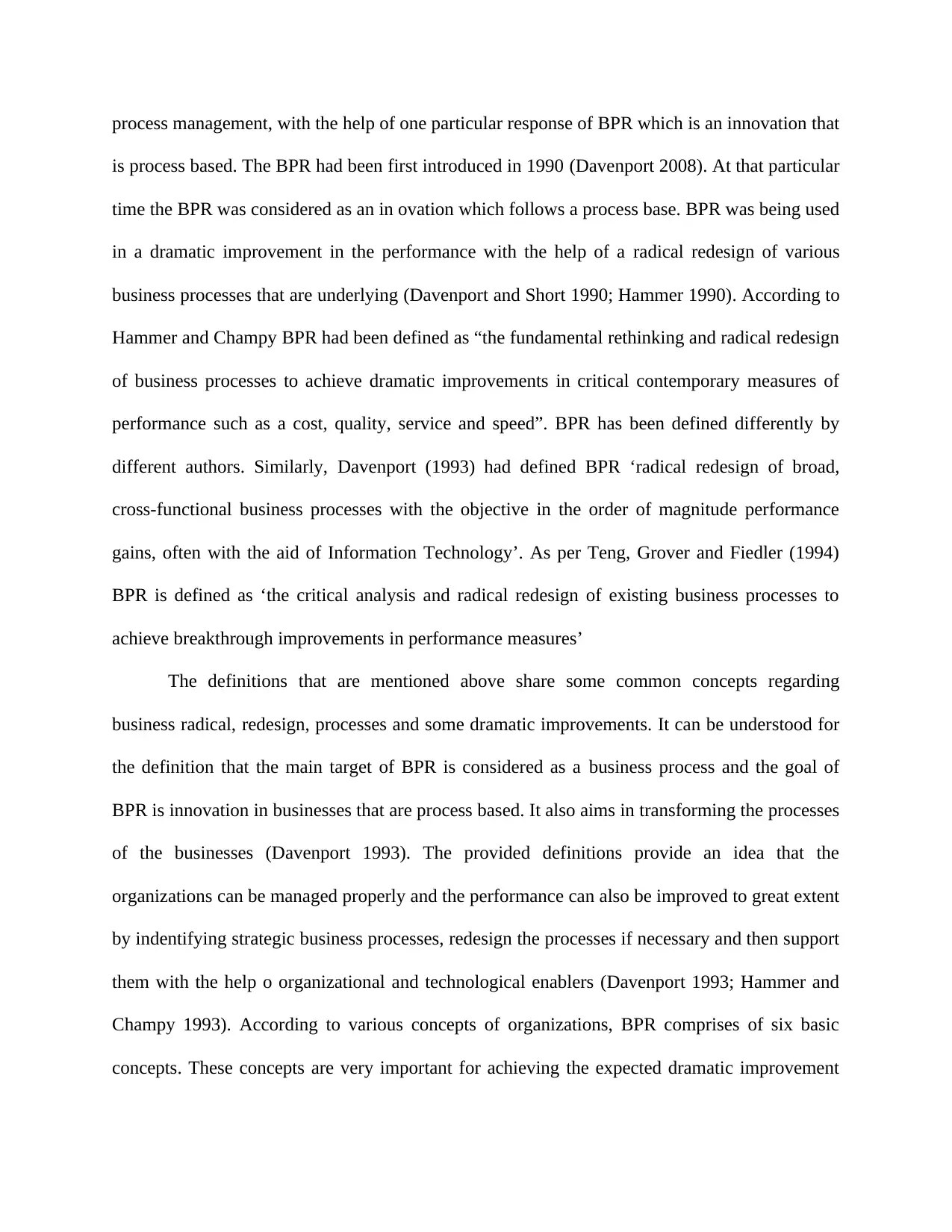
process management, with the help of one particular response of BPR which is an innovation that
is process based. The BPR had been first introduced in 1990 (Davenport 2008). At that particular
time the BPR was considered as an in ovation which follows a process base. BPR was being used
in a dramatic improvement in the performance with the help of a radical redesign of various
business processes that are underlying (Davenport and Short 1990; Hammer 1990). According to
Hammer and Champy BPR had been defined as “the fundamental rethinking and radical redesign
of business processes to achieve dramatic improvements in critical contemporary measures of
performance such as a cost, quality, service and speed”. BPR has been defined differently by
different authors. Similarly, Davenport (1993) had defined BPR ‘radical redesign of broad,
cross-functional business processes with the objective in the order of magnitude performance
gains, often with the aid of Information Technology’. As per Teng, Grover and Fiedler (1994)
BPR is defined as ‘the critical analysis and radical redesign of existing business processes to
achieve breakthrough improvements in performance measures’
The definitions that are mentioned above share some common concepts regarding
business radical, redesign, processes and some dramatic improvements. It can be understood for
the definition that the main target of BPR is considered as a business process and the goal of
BPR is innovation in businesses that are process based. It also aims in transforming the processes
of the businesses (Davenport 1993). The provided definitions provide an idea that the
organizations can be managed properly and the performance can also be improved to great extent
by indentifying strategic business processes, redesign the processes if necessary and then support
them with the help o organizational and technological enablers (Davenport 1993; Hammer and
Champy 1993). According to various concepts of organizations, BPR comprises of six basic
concepts. These concepts are very important for achieving the expected dramatic improvement
is process based. The BPR had been first introduced in 1990 (Davenport 2008). At that particular
time the BPR was considered as an in ovation which follows a process base. BPR was being used
in a dramatic improvement in the performance with the help of a radical redesign of various
business processes that are underlying (Davenport and Short 1990; Hammer 1990). According to
Hammer and Champy BPR had been defined as “the fundamental rethinking and radical redesign
of business processes to achieve dramatic improvements in critical contemporary measures of
performance such as a cost, quality, service and speed”. BPR has been defined differently by
different authors. Similarly, Davenport (1993) had defined BPR ‘radical redesign of broad,
cross-functional business processes with the objective in the order of magnitude performance
gains, often with the aid of Information Technology’. As per Teng, Grover and Fiedler (1994)
BPR is defined as ‘the critical analysis and radical redesign of existing business processes to
achieve breakthrough improvements in performance measures’
The definitions that are mentioned above share some common concepts regarding
business radical, redesign, processes and some dramatic improvements. It can be understood for
the definition that the main target of BPR is considered as a business process and the goal of
BPR is innovation in businesses that are process based. It also aims in transforming the processes
of the businesses (Davenport 1993). The provided definitions provide an idea that the
organizations can be managed properly and the performance can also be improved to great extent
by indentifying strategic business processes, redesign the processes if necessary and then support
them with the help o organizational and technological enablers (Davenport 1993; Hammer and
Champy 1993). According to various concepts of organizations, BPR comprises of six basic
concepts. These concepts are very important for achieving the expected dramatic improvement
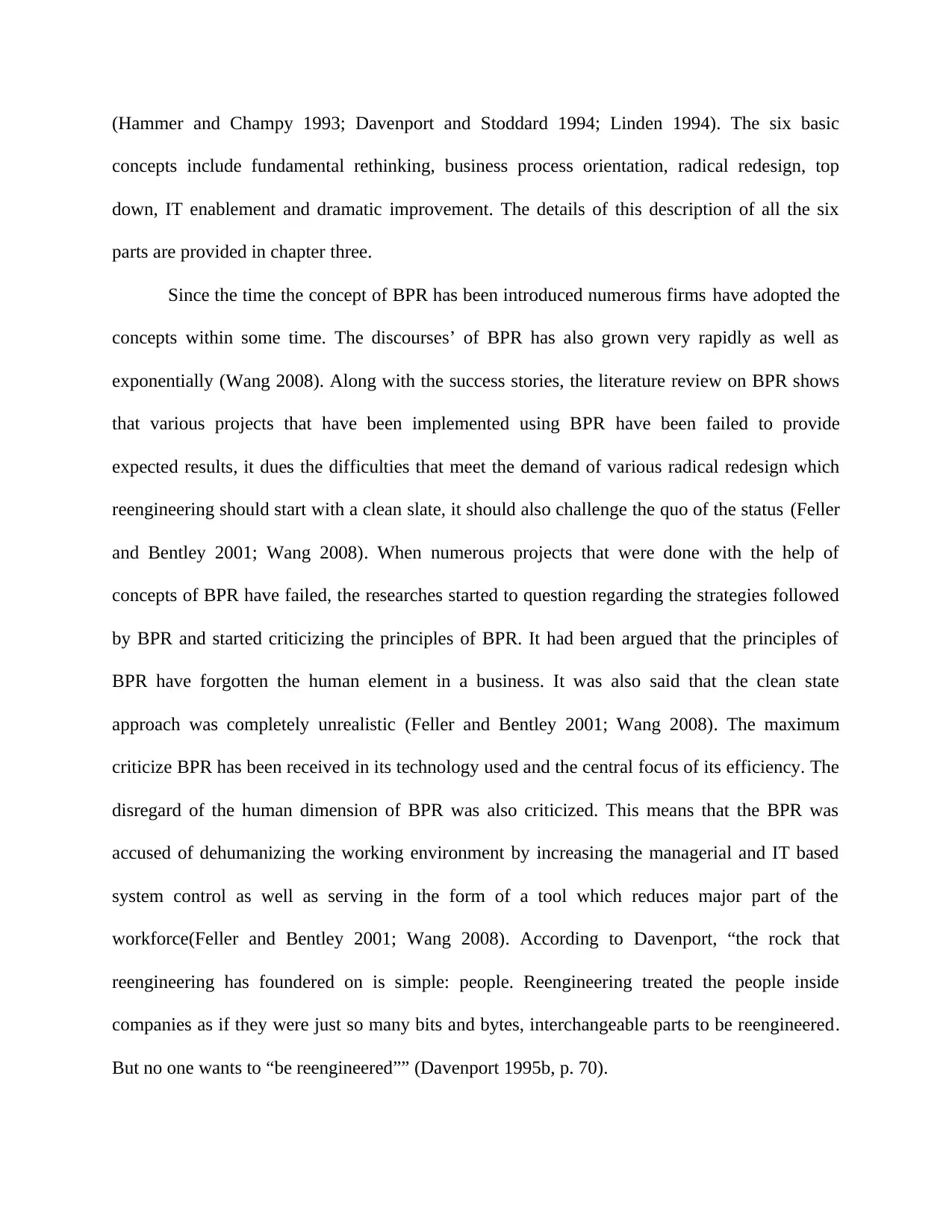
(Hammer and Champy 1993; Davenport and Stoddard 1994; Linden 1994). The six basic
concepts include fundamental rethinking, business process orientation, radical redesign, top
down, IT enablement and dramatic improvement. The details of this description of all the six
parts are provided in chapter three.
Since the time the concept of BPR has been introduced numerous firms have adopted the
concepts within some time. The discourses’ of BPR has also grown very rapidly as well as
exponentially (Wang 2008). Along with the success stories, the literature review on BPR shows
that various projects that have been implemented using BPR have been failed to provide
expected results, it dues the difficulties that meet the demand of various radical redesign which
reengineering should start with a clean slate, it should also challenge the quo of the status (Feller
and Bentley 2001; Wang 2008). When numerous projects that were done with the help of
concepts of BPR have failed, the researches started to question regarding the strategies followed
by BPR and started criticizing the principles of BPR. It had been argued that the principles of
BPR have forgotten the human element in a business. It was also said that the clean state
approach was completely unrealistic (Feller and Bentley 2001; Wang 2008). The maximum
criticize BPR has been received in its technology used and the central focus of its efficiency. The
disregard of the human dimension of BPR was also criticized. This means that the BPR was
accused of dehumanizing the working environment by increasing the managerial and IT based
system control as well as serving in the form of a tool which reduces major part of the
workforce(Feller and Bentley 2001; Wang 2008). According to Davenport, “the rock that
reengineering has foundered on is simple: people. Reengineering treated the people inside
companies as if they were just so many bits and bytes, interchangeable parts to be reengineered.
But no one wants to “be reengineered”” (Davenport 1995b, p. 70).
concepts include fundamental rethinking, business process orientation, radical redesign, top
down, IT enablement and dramatic improvement. The details of this description of all the six
parts are provided in chapter three.
Since the time the concept of BPR has been introduced numerous firms have adopted the
concepts within some time. The discourses’ of BPR has also grown very rapidly as well as
exponentially (Wang 2008). Along with the success stories, the literature review on BPR shows
that various projects that have been implemented using BPR have been failed to provide
expected results, it dues the difficulties that meet the demand of various radical redesign which
reengineering should start with a clean slate, it should also challenge the quo of the status (Feller
and Bentley 2001; Wang 2008). When numerous projects that were done with the help of
concepts of BPR have failed, the researches started to question regarding the strategies followed
by BPR and started criticizing the principles of BPR. It had been argued that the principles of
BPR have forgotten the human element in a business. It was also said that the clean state
approach was completely unrealistic (Feller and Bentley 2001; Wang 2008). The maximum
criticize BPR has been received in its technology used and the central focus of its efficiency. The
disregard of the human dimension of BPR was also criticized. This means that the BPR was
accused of dehumanizing the working environment by increasing the managerial and IT based
system control as well as serving in the form of a tool which reduces major part of the
workforce(Feller and Bentley 2001; Wang 2008). According to Davenport, “the rock that
reengineering has foundered on is simple: people. Reengineering treated the people inside
companies as if they were just so many bits and bytes, interchangeable parts to be reengineered.
But no one wants to “be reengineered”” (Davenport 1995b, p. 70).
⊘ This is a preview!⊘
Do you want full access?
Subscribe today to unlock all pages.

Trusted by 1+ million students worldwide
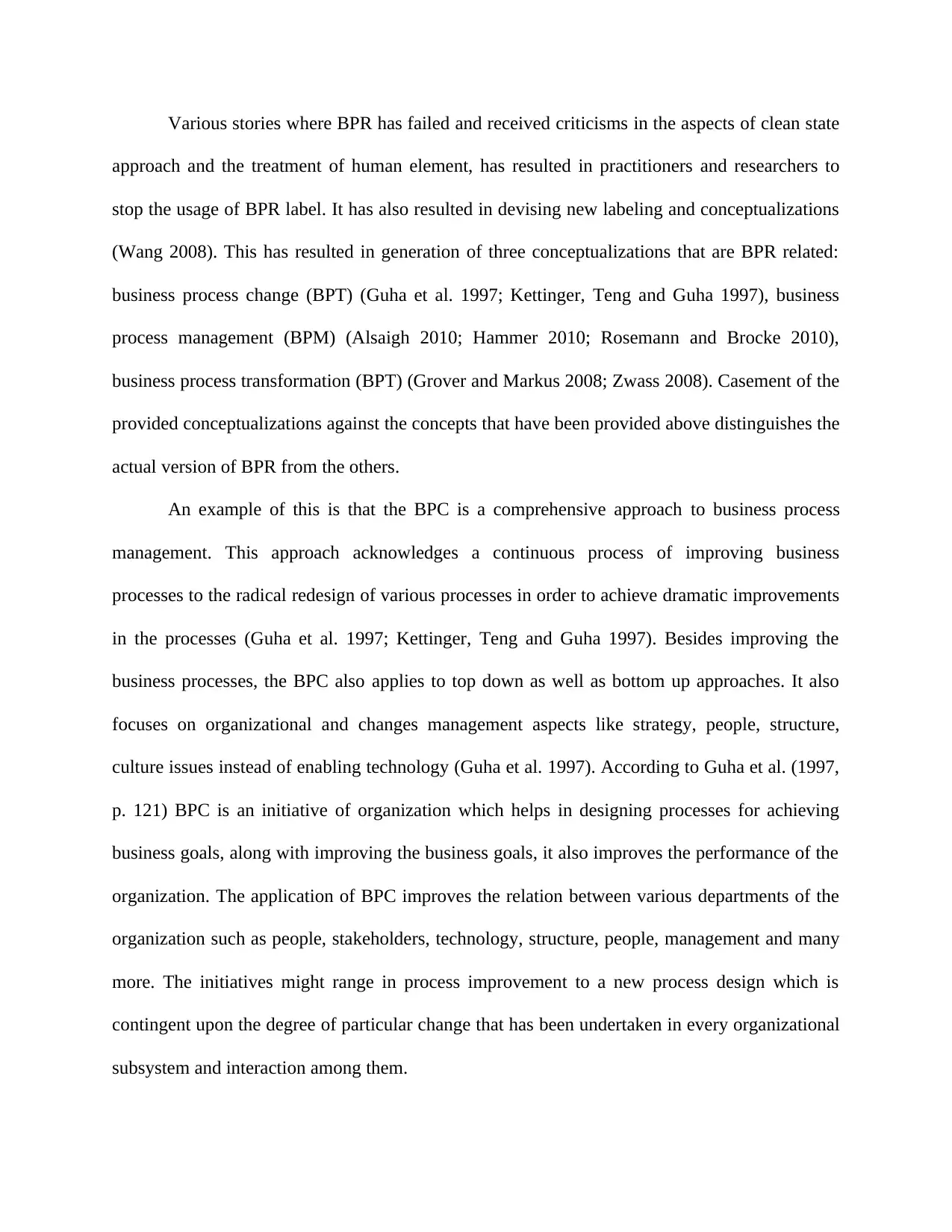
Various stories where BPR has failed and received criticisms in the aspects of clean state
approach and the treatment of human element, has resulted in practitioners and researchers to
stop the usage of BPR label. It has also resulted in devising new labeling and conceptualizations
(Wang 2008). This has resulted in generation of three conceptualizations that are BPR related:
business process change (BPT) (Guha et al. 1997; Kettinger, Teng and Guha 1997), business
process management (BPM) (Alsaigh 2010; Hammer 2010; Rosemann and Brocke 2010),
business process transformation (BPT) (Grover and Markus 2008; Zwass 2008). Casement of the
provided conceptualizations against the concepts that have been provided above distinguishes the
actual version of BPR from the others.
An example of this is that the BPC is a comprehensive approach to business process
management. This approach acknowledges a continuous process of improving business
processes to the radical redesign of various processes in order to achieve dramatic improvements
in the processes (Guha et al. 1997; Kettinger, Teng and Guha 1997). Besides improving the
business processes, the BPC also applies to top down as well as bottom up approaches. It also
focuses on organizational and changes management aspects like strategy, people, structure,
culture issues instead of enabling technology (Guha et al. 1997). According to Guha et al. (1997,
p. 121) BPC is an initiative of organization which helps in designing processes for achieving
business goals, along with improving the business goals, it also improves the performance of the
organization. The application of BPC improves the relation between various departments of the
organization such as people, stakeholders, technology, structure, people, management and many
more. The initiatives might range in process improvement to a new process design which is
contingent upon the degree of particular change that has been undertaken in every organizational
subsystem and interaction among them.
approach and the treatment of human element, has resulted in practitioners and researchers to
stop the usage of BPR label. It has also resulted in devising new labeling and conceptualizations
(Wang 2008). This has resulted in generation of three conceptualizations that are BPR related:
business process change (BPT) (Guha et al. 1997; Kettinger, Teng and Guha 1997), business
process management (BPM) (Alsaigh 2010; Hammer 2010; Rosemann and Brocke 2010),
business process transformation (BPT) (Grover and Markus 2008; Zwass 2008). Casement of the
provided conceptualizations against the concepts that have been provided above distinguishes the
actual version of BPR from the others.
An example of this is that the BPC is a comprehensive approach to business process
management. This approach acknowledges a continuous process of improving business
processes to the radical redesign of various processes in order to achieve dramatic improvements
in the processes (Guha et al. 1997; Kettinger, Teng and Guha 1997). Besides improving the
business processes, the BPC also applies to top down as well as bottom up approaches. It also
focuses on organizational and changes management aspects like strategy, people, structure,
culture issues instead of enabling technology (Guha et al. 1997). According to Guha et al. (1997,
p. 121) BPC is an initiative of organization which helps in designing processes for achieving
business goals, along with improving the business goals, it also improves the performance of the
organization. The application of BPC improves the relation between various departments of the
organization such as people, stakeholders, technology, structure, people, management and many
more. The initiatives might range in process improvement to a new process design which is
contingent upon the degree of particular change that has been undertaken in every organizational
subsystem and interaction among them.
Paraphrase This Document
Need a fresh take? Get an instant paraphrase of this document with our AI Paraphraser
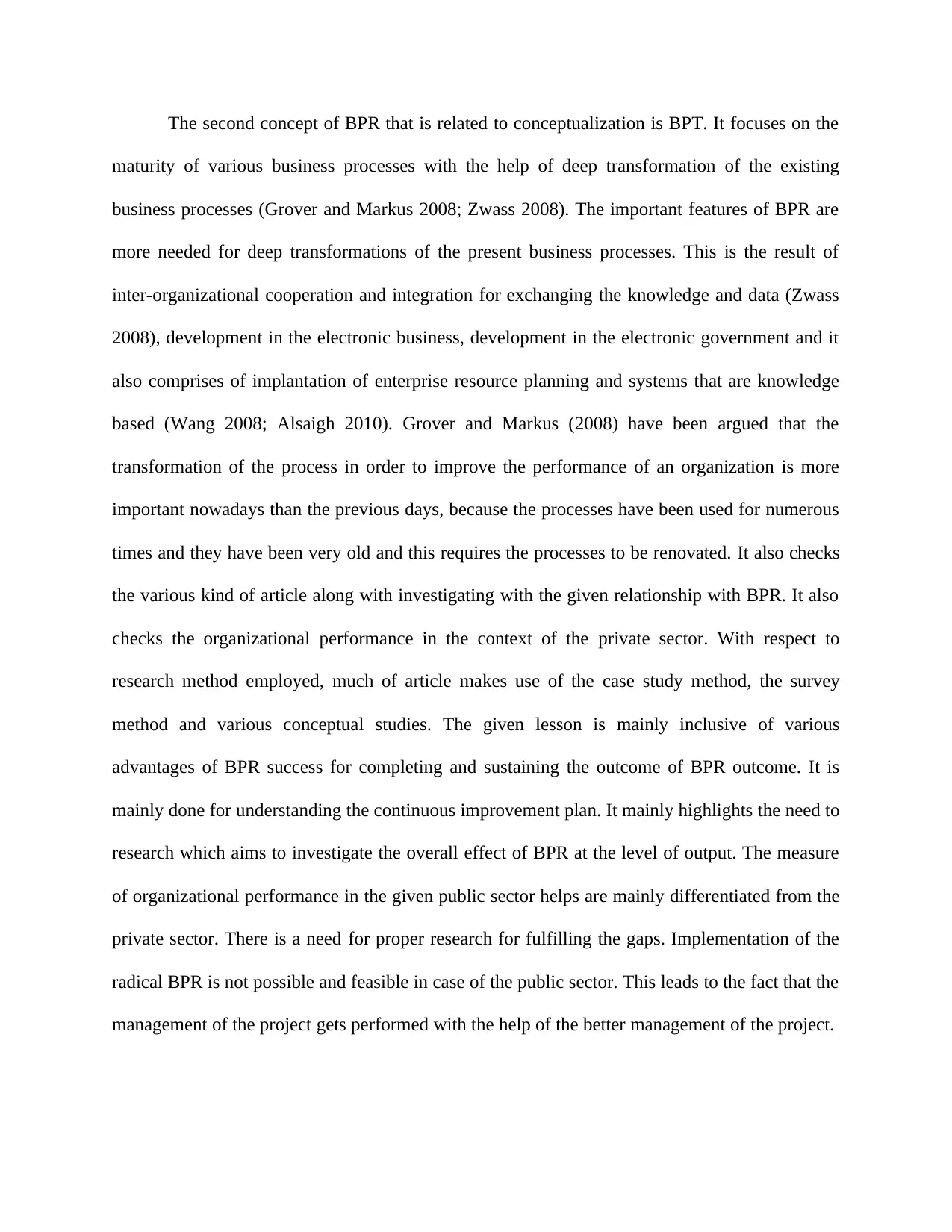
The second concept of BPR that is related to conceptualization is BPT. It focuses on the
maturity of various business processes with the help of deep transformation of the existing
business processes (Grover and Markus 2008; Zwass 2008). The important features of BPR are
more needed for deep transformations of the present business processes. This is the result of
inter-organizational cooperation and integration for exchanging the knowledge and data (Zwass
2008), development in the electronic business, development in the electronic government and it
also comprises of implantation of enterprise resource planning and systems that are knowledge
based (Wang 2008; Alsaigh 2010). Grover and Markus (2008) have been argued that the
transformation of the process in order to improve the performance of an organization is more
important nowadays than the previous days, because the processes have been used for numerous
times and they have been very old and this requires the processes to be renovated. It also checks
the various kind of article along with investigating with the given relationship with BPR. It also
checks the organizational performance in the context of the private sector. With respect to
research method employed, much of article makes use of the case study method, the survey
method and various conceptual studies. The given lesson is mainly inclusive of various
advantages of BPR success for completing and sustaining the outcome of BPR outcome. It is
mainly done for understanding the continuous improvement plan. It mainly highlights the need to
research which aims to investigate the overall effect of BPR at the level of output. The measure
of organizational performance in the given public sector helps are mainly differentiated from the
private sector. There is a need for proper research for fulfilling the gaps. Implementation of the
radical BPR is not possible and feasible in case of the public sector. This leads to the fact that the
management of the project gets performed with the help of the better management of the project.
maturity of various business processes with the help of deep transformation of the existing
business processes (Grover and Markus 2008; Zwass 2008). The important features of BPR are
more needed for deep transformations of the present business processes. This is the result of
inter-organizational cooperation and integration for exchanging the knowledge and data (Zwass
2008), development in the electronic business, development in the electronic government and it
also comprises of implantation of enterprise resource planning and systems that are knowledge
based (Wang 2008; Alsaigh 2010). Grover and Markus (2008) have been argued that the
transformation of the process in order to improve the performance of an organization is more
important nowadays than the previous days, because the processes have been used for numerous
times and they have been very old and this requires the processes to be renovated. It also checks
the various kind of article along with investigating with the given relationship with BPR. It also
checks the organizational performance in the context of the private sector. With respect to
research method employed, much of article makes use of the case study method, the survey
method and various conceptual studies. The given lesson is mainly inclusive of various
advantages of BPR success for completing and sustaining the outcome of BPR outcome. It is
mainly done for understanding the continuous improvement plan. It mainly highlights the need to
research which aims to investigate the overall effect of BPR at the level of output. The measure
of organizational performance in the given public sector helps are mainly differentiated from the
private sector. There is a need for proper research for fulfilling the gaps. Implementation of the
radical BPR is not possible and feasible in case of the public sector. This leads to the fact that the
management of the project gets performed with the help of the better management of the project.
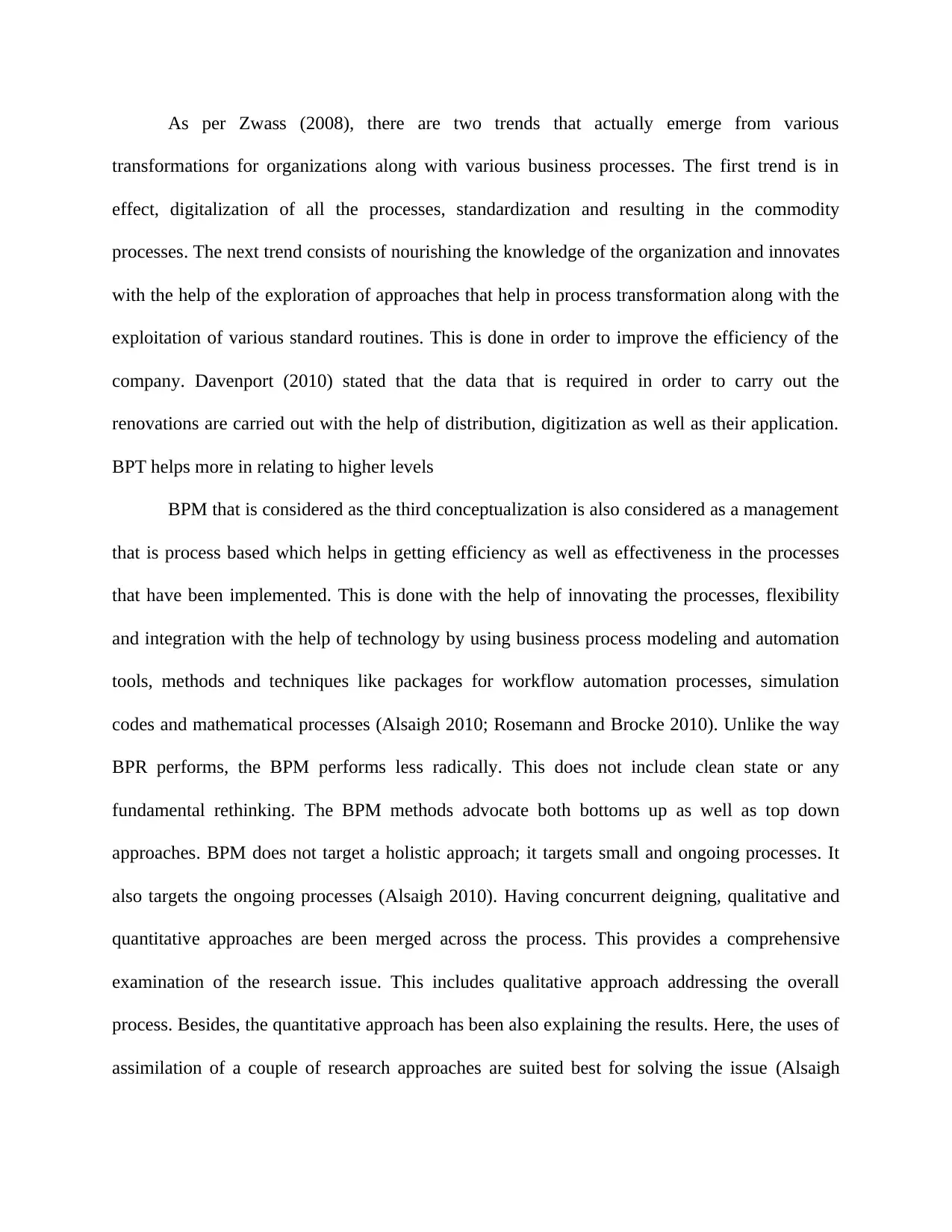
As per Zwass (2008), there are two trends that actually emerge from various
transformations for organizations along with various business processes. The first trend is in
effect, digitalization of all the processes, standardization and resulting in the commodity
processes. The next trend consists of nourishing the knowledge of the organization and innovates
with the help of the exploration of approaches that help in process transformation along with the
exploitation of various standard routines. This is done in order to improve the efficiency of the
company. Davenport (2010) stated that the data that is required in order to carry out the
renovations are carried out with the help of distribution, digitization as well as their application.
BPT helps more in relating to higher levels
BPM that is considered as the third conceptualization is also considered as a management
that is process based which helps in getting efficiency as well as effectiveness in the processes
that have been implemented. This is done with the help of innovating the processes, flexibility
and integration with the help of technology by using business process modeling and automation
tools, methods and techniques like packages for workflow automation processes, simulation
codes and mathematical processes (Alsaigh 2010; Rosemann and Brocke 2010). Unlike the way
BPR performs, the BPM performs less radically. This does not include clean state or any
fundamental rethinking. The BPM methods advocate both bottoms up as well as top down
approaches. BPM does not target a holistic approach; it targets small and ongoing processes. It
also targets the ongoing processes (Alsaigh 2010). Having concurrent deigning, qualitative and
quantitative approaches are been merged across the process. This provides a comprehensive
examination of the research issue. This includes qualitative approach addressing the overall
process. Besides, the quantitative approach has been also explaining the results. Here, the uses of
assimilation of a couple of research approaches are suited best for solving the issue (Alsaigh
transformations for organizations along with various business processes. The first trend is in
effect, digitalization of all the processes, standardization and resulting in the commodity
processes. The next trend consists of nourishing the knowledge of the organization and innovates
with the help of the exploration of approaches that help in process transformation along with the
exploitation of various standard routines. This is done in order to improve the efficiency of the
company. Davenport (2010) stated that the data that is required in order to carry out the
renovations are carried out with the help of distribution, digitization as well as their application.
BPT helps more in relating to higher levels
BPM that is considered as the third conceptualization is also considered as a management
that is process based which helps in getting efficiency as well as effectiveness in the processes
that have been implemented. This is done with the help of innovating the processes, flexibility
and integration with the help of technology by using business process modeling and automation
tools, methods and techniques like packages for workflow automation processes, simulation
codes and mathematical processes (Alsaigh 2010; Rosemann and Brocke 2010). Unlike the way
BPR performs, the BPM performs less radically. This does not include clean state or any
fundamental rethinking. The BPM methods advocate both bottoms up as well as top down
approaches. BPM does not target a holistic approach; it targets small and ongoing processes. It
also targets the ongoing processes (Alsaigh 2010). Having concurrent deigning, qualitative and
quantitative approaches are been merged across the process. This provides a comprehensive
examination of the research issue. This includes qualitative approach addressing the overall
process. Besides, the quantitative approach has been also explaining the results. Here, the uses of
assimilation of a couple of research approaches are suited best for solving the issue (Alsaigh
⊘ This is a preview!⊘
Do you want full access?
Subscribe today to unlock all pages.

Trusted by 1+ million students worldwide
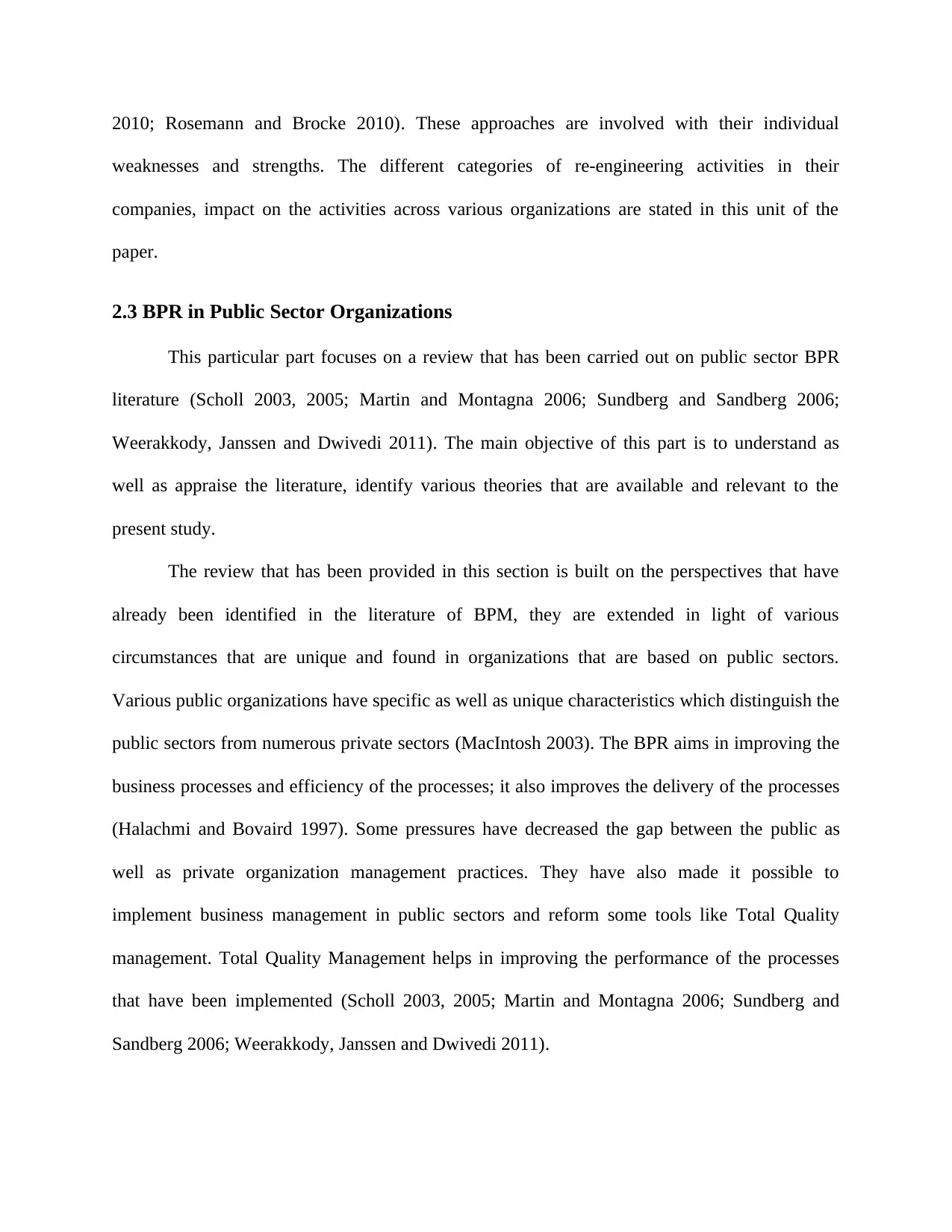
2010; Rosemann and Brocke 2010). These approaches are involved with their individual
weaknesses and strengths. The different categories of re-engineering activities in their
companies, impact on the activities across various organizations are stated in this unit of the
paper.
2.3 BPR in Public Sector Organizations
This particular part focuses on a review that has been carried out on public sector BPR
literature (Scholl 2003, 2005; Martin and Montagna 2006; Sundberg and Sandberg 2006;
Weerakkody, Janssen and Dwivedi 2011). The main objective of this part is to understand as
well as appraise the literature, identify various theories that are available and relevant to the
present study.
The review that has been provided in this section is built on the perspectives that have
already been identified in the literature of BPM, they are extended in light of various
circumstances that are unique and found in organizations that are based on public sectors.
Various public organizations have specific as well as unique characteristics which distinguish the
public sectors from numerous private sectors (MacIntosh 2003). The BPR aims in improving the
business processes and efficiency of the processes; it also improves the delivery of the processes
(Halachmi and Bovaird 1997). Some pressures have decreased the gap between the public as
well as private organization management practices. They have also made it possible to
implement business management in public sectors and reform some tools like Total Quality
management. Total Quality Management helps in improving the performance of the processes
that have been implemented (Scholl 2003, 2005; Martin and Montagna 2006; Sundberg and
Sandberg 2006; Weerakkody, Janssen and Dwivedi 2011).
weaknesses and strengths. The different categories of re-engineering activities in their
companies, impact on the activities across various organizations are stated in this unit of the
paper.
2.3 BPR in Public Sector Organizations
This particular part focuses on a review that has been carried out on public sector BPR
literature (Scholl 2003, 2005; Martin and Montagna 2006; Sundberg and Sandberg 2006;
Weerakkody, Janssen and Dwivedi 2011). The main objective of this part is to understand as
well as appraise the literature, identify various theories that are available and relevant to the
present study.
The review that has been provided in this section is built on the perspectives that have
already been identified in the literature of BPM, they are extended in light of various
circumstances that are unique and found in organizations that are based on public sectors.
Various public organizations have specific as well as unique characteristics which distinguish the
public sectors from numerous private sectors (MacIntosh 2003). The BPR aims in improving the
business processes and efficiency of the processes; it also improves the delivery of the processes
(Halachmi and Bovaird 1997). Some pressures have decreased the gap between the public as
well as private organization management practices. They have also made it possible to
implement business management in public sectors and reform some tools like Total Quality
management. Total Quality Management helps in improving the performance of the processes
that have been implemented (Scholl 2003, 2005; Martin and Montagna 2006; Sundberg and
Sandberg 2006; Weerakkody, Janssen and Dwivedi 2011).
Paraphrase This Document
Need a fresh take? Get an instant paraphrase of this document with our AI Paraphraser
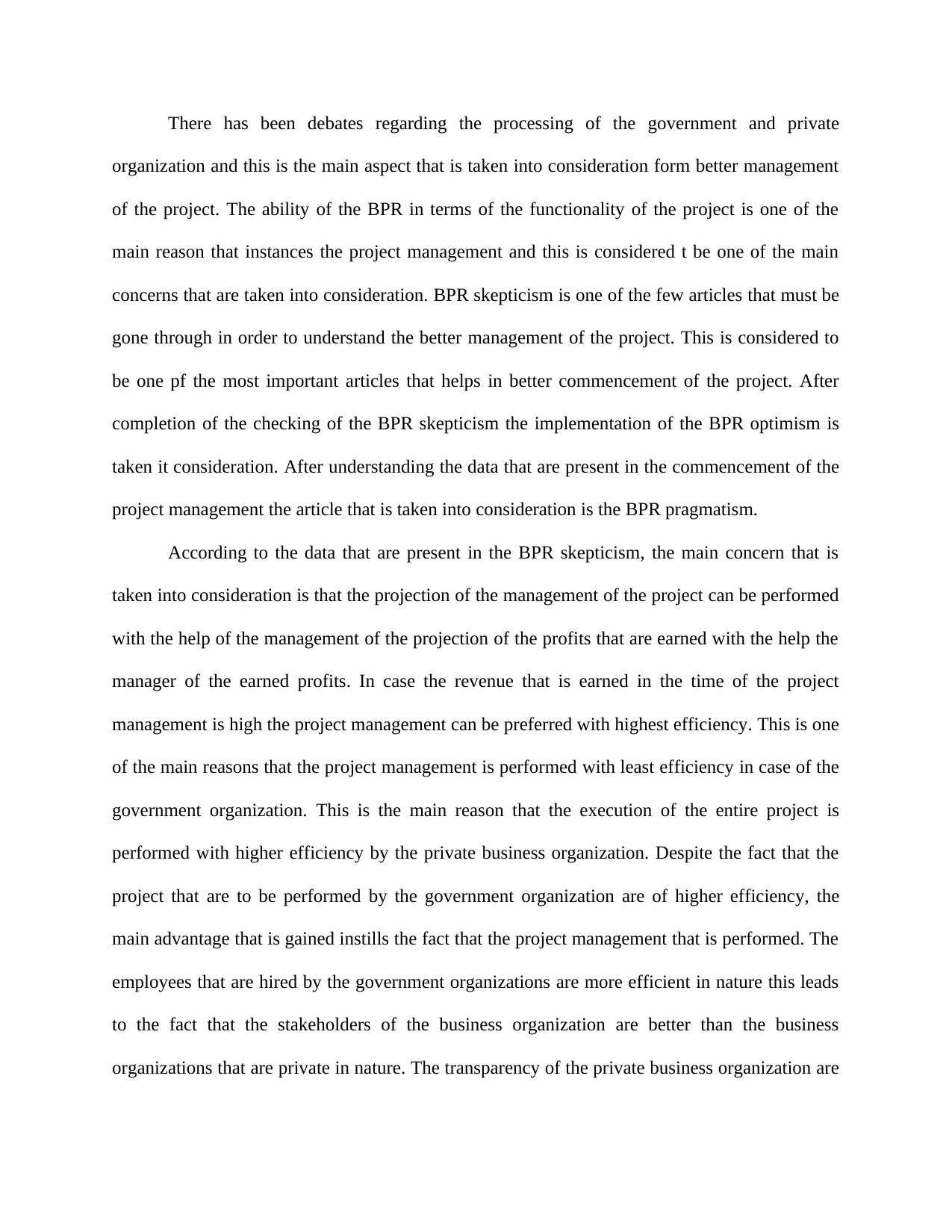
There has been debates regarding the processing of the government and private
organization and this is the main aspect that is taken into consideration form better management
of the project. The ability of the BPR in terms of the functionality of the project is one of the
main reason that instances the project management and this is considered t be one of the main
concerns that are taken into consideration. BPR skepticism is one of the few articles that must be
gone through in order to understand the better management of the project. This is considered to
be one pf the most important articles that helps in better commencement of the project. After
completion of the checking of the BPR skepticism the implementation of the BPR optimism is
taken it consideration. After understanding the data that are present in the commencement of the
project management the article that is taken into consideration is the BPR pragmatism.
According to the data that are present in the BPR skepticism, the main concern that is
taken into consideration is that the projection of the management of the project can be performed
with the help of the management of the projection of the profits that are earned with the help the
manager of the earned profits. In case the revenue that is earned in the time of the project
management is high the project management can be preferred with highest efficiency. This is one
of the main reasons that the project management is performed with least efficiency in case of the
government organization. This is the main reason that the execution of the entire project is
performed with higher efficiency by the private business organization. Despite the fact that the
project that are to be performed by the government organization are of higher efficiency, the
main advantage that is gained instills the fact that the project management that is performed. The
employees that are hired by the government organizations are more efficient in nature this leads
to the fact that the stakeholders of the business organization are better than the business
organizations that are private in nature. The transparency of the private business organization are
organization and this is the main aspect that is taken into consideration form better management
of the project. The ability of the BPR in terms of the functionality of the project is one of the
main reason that instances the project management and this is considered t be one of the main
concerns that are taken into consideration. BPR skepticism is one of the few articles that must be
gone through in order to understand the better management of the project. This is considered to
be one pf the most important articles that helps in better commencement of the project. After
completion of the checking of the BPR skepticism the implementation of the BPR optimism is
taken it consideration. After understanding the data that are present in the commencement of the
project management the article that is taken into consideration is the BPR pragmatism.
According to the data that are present in the BPR skepticism, the main concern that is
taken into consideration is that the projection of the management of the project can be performed
with the help of the management of the projection of the profits that are earned with the help the
manager of the earned profits. In case the revenue that is earned in the time of the project
management is high the project management can be preferred with highest efficiency. This is one
of the main reasons that the project management is performed with least efficiency in case of the
government organization. This is the main reason that the execution of the entire project is
performed with higher efficiency by the private business organization. Despite the fact that the
project that are to be performed by the government organization are of higher efficiency, the
main advantage that is gained instills the fact that the project management that is performed. The
employees that are hired by the government organizations are more efficient in nature this leads
to the fact that the stakeholders of the business organization are better than the business
organizations that are private in nature. The transparency of the private business organization are
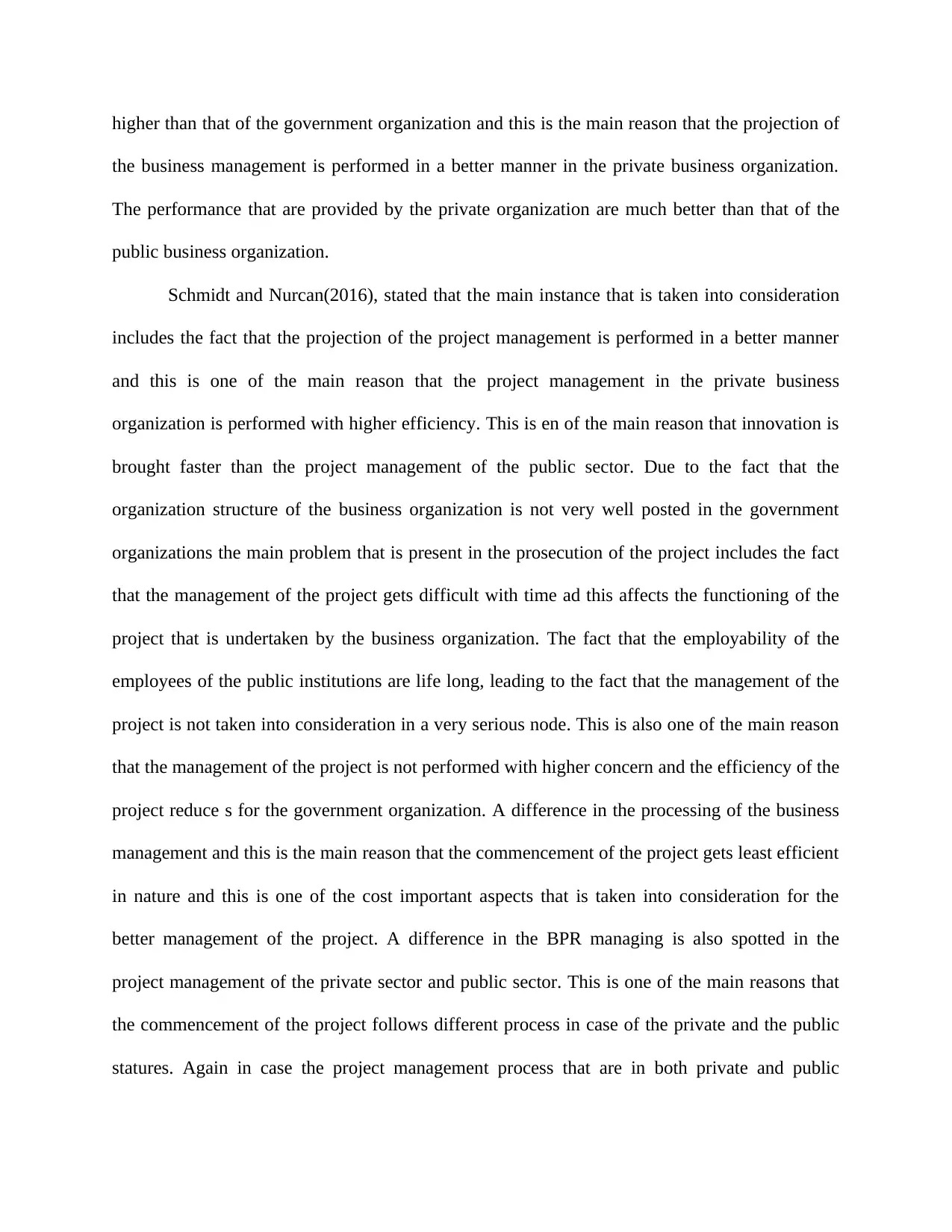
higher than that of the government organization and this is the main reason that the projection of
the business management is performed in a better manner in the private business organization.
The performance that are provided by the private organization are much better than that of the
public business organization.
Schmidt and Nurcan(2016), stated that the main instance that is taken into consideration
includes the fact that the projection of the project management is performed in a better manner
and this is one of the main reason that the project management in the private business
organization is performed with higher efficiency. This is en of the main reason that innovation is
brought faster than the project management of the public sector. Due to the fact that the
organization structure of the business organization is not very well posted in the government
organizations the main problem that is present in the prosecution of the project includes the fact
that the management of the project gets difficult with time ad this affects the functioning of the
project that is undertaken by the business organization. The fact that the employability of the
employees of the public institutions are life long, leading to the fact that the management of the
project is not taken into consideration in a very serious node. This is also one of the main reason
that the management of the project is not performed with higher concern and the efficiency of the
project reduce s for the government organization. A difference in the processing of the business
management and this is the main reason that the commencement of the project gets least efficient
in nature and this is one of the cost important aspects that is taken into consideration for the
better management of the project. A difference in the BPR managing is also spotted in the
project management of the private sector and public sector. This is one of the main reasons that
the commencement of the project follows different process in case of the private and the public
statures. Again in case the project management process that are in both private and public
the business management is performed in a better manner in the private business organization.
The performance that are provided by the private organization are much better than that of the
public business organization.
Schmidt and Nurcan(2016), stated that the main instance that is taken into consideration
includes the fact that the projection of the project management is performed in a better manner
and this is one of the main reason that the project management in the private business
organization is performed with higher efficiency. This is en of the main reason that innovation is
brought faster than the project management of the public sector. Due to the fact that the
organization structure of the business organization is not very well posted in the government
organizations the main problem that is present in the prosecution of the project includes the fact
that the management of the project gets difficult with time ad this affects the functioning of the
project that is undertaken by the business organization. The fact that the employability of the
employees of the public institutions are life long, leading to the fact that the management of the
project is not taken into consideration in a very serious node. This is also one of the main reason
that the management of the project is not performed with higher concern and the efficiency of the
project reduce s for the government organization. A difference in the processing of the business
management and this is the main reason that the commencement of the project gets least efficient
in nature and this is one of the cost important aspects that is taken into consideration for the
better management of the project. A difference in the BPR managing is also spotted in the
project management of the private sector and public sector. This is one of the main reasons that
the commencement of the project follows different process in case of the private and the public
statures. Again in case the project management process that are in both private and public
⊘ This is a preview!⊘
Do you want full access?
Subscribe today to unlock all pages.

Trusted by 1+ million students worldwide
1 out of 59
Related Documents
Your All-in-One AI-Powered Toolkit for Academic Success.
+13062052269
info@desklib.com
Available 24*7 on WhatsApp / Email
![[object Object]](/_next/static/media/star-bottom.7253800d.svg)
Unlock your academic potential
Copyright © 2020–2025 A2Z Services. All Rights Reserved. Developed and managed by ZUCOL.





